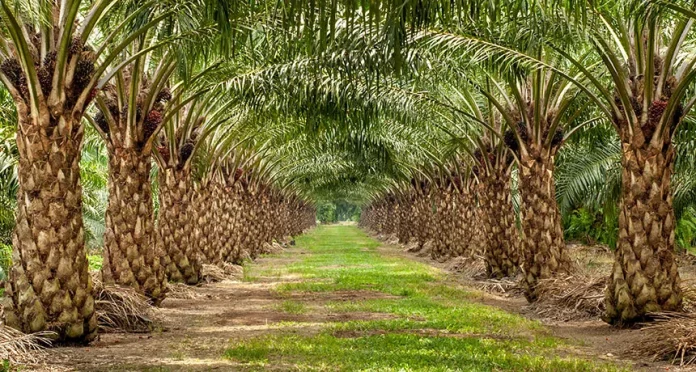When palm oil prices soared to record highs last year, a Malaysian estate manager surnamed Lim postponed replanting his old, unproductive trees for a third consecutive year to lock in profits — a decision he regrets and is scrambling to fix.
Across Indonesia and Malaysia, which produce 85 per cent of the world’s palm oil, growers are ramping up replanting after a decade of letting estates grow older, an ageing trend that threatens to tighten the supply of the commodity that accounts for nearly 60 per cent of global vegetable oil.
Oil palms start losing productivity after 20 years. Besides the cost of replanting, it takes three years for new trees to grow and yield a crop – making that land unproductive in the meantime.
“If I had replanted consistently over the past 10 to 15 years, my yields and worker productivity could have been better,” said Lim, now rushing to catch up on the backlog by replanting five per cent of his 2,300-hectare estate in Perak this year, and up to 20 per cent next year.
“The joy from the high prices was short-lived,” said Lim, referring to prices that reached a record RM7,268 (US$1,647.33) a tonne last year. Lim wanted to be referred to only by his family name due to business confidentiality,
With acreage planted to palm oil mostly static in Indonesia and Malaysia and some palm oil is used to meet biofuel targets, the need is intensifying for higher yields of the commodity used in cooking oil, instant noodles, soaps, cosmetics and other products.
Palm oil prices have fallen some 49 per cent from last year’s record, but the tight supply means they are expected to stay above pre-pandemic levels.
Malaysia’s FGV Holdings, the world’s biggest palm oil producer, told Reuters it will expand its pool of replanting contractors and aims to replant 19,549 hectares this year, up from 12,436 hectares in 2022 and just 2,023 hectares in 2021.
Another palm oil giant, Kuala Lumpur Kepong Bhd, told Reuters it plans to replant 10,000 hectares this year, up from a lower-than-usual 6,000 hectares in 2022.
In addition to the temptation of high harvest prices, growers were deterred from replanting in recent years by rising costs and a shortage of workers during the pandemic, especially in migrant labour-reliant Malaysia. Efforts to address investor concerns on sustainability and labour rights, which saw many growers spend to upgrade housing, also distracted from replanting.
As a result, yields stagnated over the past four years, even as scant new acreage was planted under government caps to prevent deforestation.
Now, with prices falling and labour woes easing, estate managers like Lim are stepping up replanting to lower the ageing profile of their plantations.
“We are ramping up full speed. We will replant as much as the seedling supplier can supply,” said Lim.
‘Ugly Ageing Trend’
“Palm oil has lost its growth momentum … Insufficient replantings and management constraints are keeping yields below potential,” Thomas Mielke, head of Hamburg-based research firm Oil World, told a conference last month.
Annual global output growth is likely to slow to 1.9 million tonnes or less in the current decade, from average annual growth of 2.9 million tonnes in the 10 years to 2020, Mielke said.
World output this year is expected to increase by 2.7 per cent from a year ago to 80.9 million tonnes, Mielke said.
In 2017, Indonesia launched a smallholder replanting fund to support the growers who account for over 40% of its palm acreage. Yields for smallholders are 25 per cent lower than for company-run plantations due to ageing trees and poor-quality seedlings.
The scheme targeted replanting of 2.4 million hectares but only managed to replant around 278,000 hectares by February, partly due to land legality issues.
Indonesian agriculture ministry official Muhammad Rizal said that many farmers withdrew their replanting proposals last year to take advantage of high prices.
“When fresh fruit bunch prices rose, this became problematic,” he told Reuters.
In neighbouring Malaysia, where oil palms tend to be older, the replanting rate in 2022 slowed to 100,000 hectares from 160,000 hectares replanted in 2020, according to the Malaysian Palm Oil Board.
Around 2.32 million hectares or nearly 15 per cent of Indonesia’s oil palms are more than 20 years old, compared to nearly 27 per cent in Malaysia’s total planted area of 5.67 million hectares, according to government data provided to Reuters.
The oldest and least productive trees — those aged 25 or more — account for four per cent of total planted acreage in Indonesia and twice that in Malaysia.
“There is an ugly ageing trend. We are ageing faster than we are replanting,” Malaysia Palm Oil Association chief executive Joseph Tek told Reuters.
Faster, Shorter
While new seed varieties grow faster into trees that produce more oil, are shorter and easier to harvest and may also have better resistance to drought and disease, replanting remains expensive, especially for smallholders and mid-sized estates.
In Malaysia, replanting costs doubled to around US$4,500 (RM19743.75) per hectare after the pandemic inflated prices of fertiliser and labour.
Indonesia is adjusting regulations to make its replanting fund more accessible to farmers as the country aims to replant 180,000 hectares of smallholder farms this year, Rizal said.
However, the threat of El Nino-induced droughts, seed shortages, labour supply disruptions and rising costs for everything from contractors to pesticides may force some planters to wait another year.
“We should see a little bit more from the major plantation companies who are more disciplined on replanting, to try and correct the age profile for the estate,” said Ivy Ng, regional head of plantations research at CGS-CIMB Research.
“But it continues to be an expensive investment and requires workers,” she said. — Reuters









